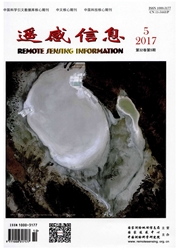

 中文摘要:
中文摘要:
以渭干河——库车河三角洲绿洲为例,利用SAR数据,采用不同的分类方法来提取该研究区盐渍化土地覆盖信息。首先用Enhanced frost滤波算法对SAR图像进行去噪处理。然后基于灰度共生矩阵理论提取去噪后的SAR图像4种纹理特征,并在不同窗口大小下筛选出有效的纹理特征。最后结合纹理特征分别采用最大似然分类法和SVM分类法对SAR图像进行分类。研究结果表明:基于纹理特征的SVM分类方法,能够有效解决单源数据信息图像分类效果破碎问题;13×13窗口的总精度达到98.2456%,Kappa系数达到0.9763,更有利于遥感图像分类和盐渍化信息监测,是地物遥感信息提取的有效途径。
 英文摘要:
英文摘要:
Support Vector Machine(SVM) is a new-style classification method.The authors took the Delta oases of Weigan and kuqa rivers as examples,using SAR data and different methods to extract the salinization cover information.Firstly,the speckles from SAR image are eliminated by the enhanced Frost filter algorithm.Then the texture features of the denoised SAR image are extracted based on gray co-occurrence matrix,and the effective texture features are screened through the different size windows.At last,combining with texture features,SAR image is classified with the classical maximum likelihood and SVM classification methods.This study shows that the classification based on SVM method can solve the problem of image broken which was occurred while classification was based on the single-source data,and has the good generalization ability with the high dimension vector.The classification precision of the window of 13×13 is up to 98.2456% and kappa coefficient up to 0.9763.Therefore,the classification method by SVM based on texture characteristics can be adapted to SAR image classification and monitoring of soil salinization,and furthermore,provides an effective way for remote sensing information extraction.
 同期刊论文项目
同期刊论文项目
 同项目期刊论文
同项目期刊论文
 Application study of the thermal infrared emissivity spectra in the estimation of salt content of sa
Application study of the thermal infrared emissivity spectra in the estimation of salt content of sa Spectral reflectance properties of major objects in desert oasis: a case study of the Weigan-Kuqa ri
Spectral reflectance properties of major objects in desert oasis: a case study of the Weigan-Kuqa ri A Method of Soil Salinization Information Extraction with SVM Classfication Based on ICA and Texture
A Method of Soil Salinization Information Extraction with SVM Classfication Based on ICA and Texture 期刊信息
期刊信息
